Summer break is over! Ready for AI integration?
Revolutionizing Education: Integrating AI in the Classroom
As educators get ready to go back to school after summer break many questions have been popping up about todays technological advancements. One such advancement is the integration of Artificial Intelligence (AI) in the classroom.
Traditional school board policies often struggle to keep pace with the rapid advancements in AI technology. As a result, teachers find themselves in a conundrum: how can they safely integrate AI into their classrooms without established policies to follow?
However, embracing AI in education offers tremendous benefits. It provides students with the opportunity to learn authentically and be better prepared for the future. By leveraging AI technologies, students can engage with interactive and personalized learning experiences, fostering critical thinking and problem-solving skills.
Ensuring Authentic Learning
One question that arises when integrating AI in education is how students can ensure they are learning authentically. While AI tools can provide valuable assistance, it is essential to strike a balance.
Students should actively participate in the learning process and not overly rely on AI as a substitute for genuine understanding. Emphasizing the importance of critical thinking and independent research can help maintain the authenticity of the learning experience.
The Future and What Lies Ahead
As we look to the future, it's clear that AI will continue to play a significant role in education. The rate of technological advancement is relentless, and it is difficult to predict what lies ahead. Nevertheless, we must adapt and prepare ourselves for the changes that will shape the future of education.
While we may not have all the answers, there are steps we can take. Firstly, educators, policymakers, and technology experts must collaborate to develop comprehensive guidelines and policies for AI integration in education. By establishing a framework that ensures ethical and responsible use of AI, we can create a safe and productive learning environment for students.
Secondly, students should be encouraged to actively engage with AI tools while maintaining their critical thinking skills. They must understand how AI works and its limitations, ensuring they become informed users of this powerful technology.
Frequently Asked Questions
Q: Can AI completely replace human teachers?
No, AI cannot replace human teachers. While AI can provide valuable support and enhance the learning experience, human interaction, empathy, and guidance are indispensable aspects of education.
Q: What measures should be taken to protect student data when using AI?
Protecting student data should be a top priority when integrating AI in education. Schools should establish robust data privacy policies and ensure compliance with relevant regulations. Additionally, using secure and reputable AI platforms with built-in privacy features can help safeguard student information.
Q: How can AI help students with diverse learning needs?
AI can cater to diverse learning needs by providing personalized and adaptive learning experiences. Through AI-powered tools, students can receive targeted support, customized feedback, and individualized learning paths, allowing them to progress at their own pace.
Q: Will AI replace traditional education methods entirely?
No, AI is not meant to replace traditional education methods but rather enhance them. AI technologies can complement existing educational approaches, providing additional resources, insights, and support to both students and teachers.
Moving Forward
The integration of AI in education has the potential to revolutionize the way we learn. By embracing this transformative technology, educators can create authentic and engaging learning experiences that prepare students for the future. While challenges exist, collaboration, policy development, and informed usage of AI can pave the way for an exciting and promising future of education.





Comments
Post a Comment